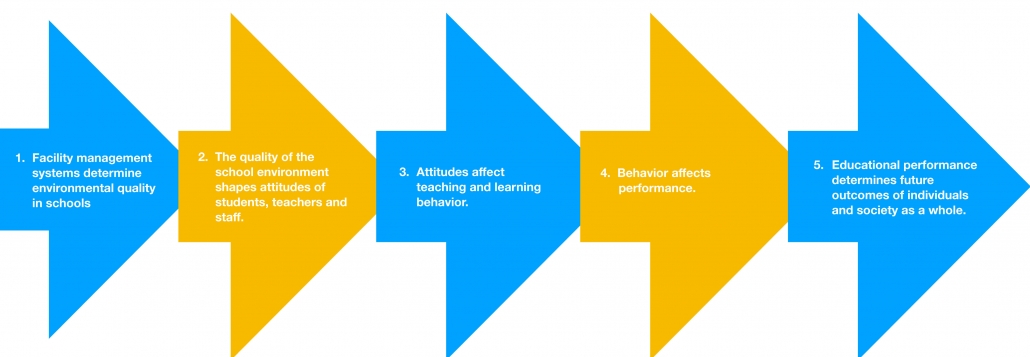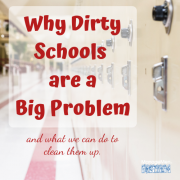Why Dirty Schools are a Big Problem—and What We Can Do to Clean Them Up
Last year, the Chicago Public School (CPS) system had a major cleaning problem on its hands. When it outsourced cleaning services, it promised the move would save the district money, provide cleaner schools and reduce responsibilities within individual schools.
That didn’t happen.
An investigation by a local newspaper revealed that 91 of 125 schools failed cleanliness inspections by an outside inspector, and the Chicago Board of Education wanted action. They wanted accountability from the contractors hired to oversee cleaning duties.
Roaches, dirty floors, missing restroom supplies were just a few of the issues. Several cleaners reported that they used personal funds to purchase cleaning supplies. Within the schools, so many hands were tied. Administrators couldn’t do anything about the issue. Teachers started leaving, dismayed by the filthy environment and kids—well, the kids suffered the most.
The Issue with Dirty Schools
A lot of people want to know what REALLY happens when schools are dirty. The truth is, a lot can happen.
Former EPA scientist Dr. Michael Berry has studied the impact of cleaning on our schools extensively. In his study “Educational Performance, Environmental Management, and Cleaning Effectiveness in School Environments,” he concludes, “effective cleaning programs enhance school and student positive self-image, and may promote overall higher academic attendance and performance.”
While Dr. Berry was specifically making the case for effective maintenance as a strategy for revitalizing aging city schools, he demonstrated the link between a school’s environmental quality and the educational performance of its students. Ultimately, he says, clean schools are not just an issue for parents and school staff, but our communities.

A few weeks ago, we shared an awesome letter to the editor from a concerned parent in a school district that was outsourcing its custodial services. She (legitimately) questioned how students would be impacted through the move.
Here are just a few of the problems associated with dirty schools:
1. Increased illnesses and absenteeism.
2. Reduced performance.
3. Students and staff take less pride in the school, which reduces moral.
4. Schools experience higher teacher and employee turnover. Higher turnover impacts student’s learning and opportunities for achievement.
5. Reduced property value.
What We Can Do About Dirty Schools
There are a lot of clean schools in our country, but there are also a lot of really dirty schools as well, and it shouldn’t take an investigation to reveal issues with cleanliness. A lot of times the cleanliness of a school is tied to funding, not surprisingly.
As a parent, school administrator or just concerned citizen, what can you do to help make sure we’re offering a clean and safe facility for children to learn and grow?
1. Improve job descriptions for janitors. According to the National Education Association, 38 percent of janitors have no job description and 32 percent of those who do have a job description feel it does not match the scope of their work. Make sure job descriptions have been updated and accurately reflect the work the janitor performs. An effective scope of work is the first step to making sure cleaning is performed as required.
2. Allocate funds for training. Too often, we put a vacuum or mop in a janitor’s hand and tell them to clean, assuming they know what to do… but they often don’t. By allocating funds for cleaning programs, products and training, school custodians can have the tools they need to clean properly, while also understanding the basic science of their job, including microbiology, how to prevent cross contamination, etc.
3. Scrutinize RFPs before they go to bid. Cleaning services have become increasingly commoditized, so it’s important to make sure that when your district issues an RFP, specs for cleaning are clearly identified so services aren’t cut to the lowest priced bidder. Green Seal’s GS-42 is a great framework for an RFP.
4. Advocate for better cleaning standards and programs. As Dr. Campbell noted in his report Clean Schools Initiative, “National cleaning, facility and education associations, states, school districts, etc. must establish a common vocabulary with clearly identified standards, training competencies, measures and outcomes that focus on healthy environments that improve quality of life and human performance.”
If you’re looking to turn around a cleaning program at a school, we’ve got you covered. Just check out this case study from the Provo City Schools that showed how a systematic approach to cleaning was able to reverse some of the all-too-familiar challenges of a poor cleaning program.
5. Thank a Cleaner. While it might seem tongue-in-cheek, the single most important thing a parent, student, teacher or administrator can do to improve cleaning in schools is show appreciation for the people doing the cleaning. The task is hard and often thankless, so showing custodial workers that you see them and appreciate the work they are doing goes a long way.
As the late Nelson Mandela wrote, “Education is the most powerful weapon which you can use to change the world.”
As children across the nation prepare to return to schools, let’s do what we can to provide an optimal learning environment for them. Clean schools matter.

